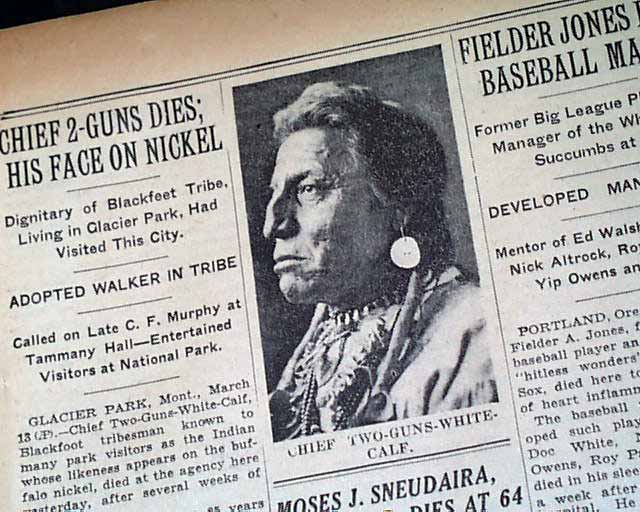Home >
1934 Chief Two-Guns death... John Dillinger...
1934 Chief Two-Guns death... John Dillinger...
Item # 576784
Currently Unavailable. Contact us if you would like to be placed on a want list or to be notified if a similar item is available.
March 14, 1934
THE NEW YORK TIMES, March 14, 1934
* Chief Two Guns - White Calf death
* 'Indian head' nickel fame
* Famous John Dillinger bank robbery
This 40 page newspaper has one column headlines on page 19 that include: "CHIEF 2-GUNS DIES; HIS FACE ON NICKEL", "Dignitary of Blackfeet Tribe, Living In Glacier Park, Had Visited This City" and more with photo of the chief (see photos).
Also one column headlines on page 4 that include: "IOWA BANK BANDITS FLEE WITH $52,344", "Seven Machine Gunners Use Bystanders as Shields From Gunfire at Mason City" and more (see photos).
Tells of the bank robbery in Mason City, Iowa that was later proven to be indeed John Dillinger's work. This was done shortly after his famous escape from Crown Point jail in Indiana.
Other news of the day including various advertisements. Light browning with little margin wear, otherwise good.
wikipedia notes: The Bureau of Investigation was brought into the investigation to help identify the criminals, although the men had not violated any federal law. It was one of the first cases in which the BOI intervened in matters outside its jurisdiction. Using their superior fingerprint matching technology, they successfully identified all of the suspects and issued national bulletins offering rewards for their capture.
Dillinger and his gang, in the meantime, began a streak of bank robberies across Indiana, although the first bank he ever robbed was in New Carlisle, Ohio on June 10, 1933. Among Dillinger's more celebrated exploits involved his pretending to be a sales representative for a company that sold bank alarm systems. He reportedly entered a number of Indiana and Ohio banks and used this ruse to assess security systems and bank vaults of prospective targets. Another time, the gang pretended to be part of a film company that was scouting locations for a "bank robbery" scene. Bystanders stood and smiled as a real robbery ensued and Dillinger and friends escaped with the loot. Stories such as this only served to increase Dillinger's burgeoning legend. Dillinger was believed to have been associated with gangs who robbed dozens of banks and accumulating a total of more than $300,000. Banks allegedly robbed by Dillinger and his associates included the Commercial Bank, Daleville, Indiana of $3,500 on July 17, 1933; Montpelier National Bank, Montpelier, Indiana of $6,700 on August 4, 1933; Bluffton Bank, Bluffton, Ohio, of $6,000 on August 14, 1933; Massachusetts Avenue State Bank, Indianapolis, Indiana, of $21,000 on September 6, 1933; Central National Bank and Trust Co., Greencastle, Indiana, of $74,000 on October 23, 1933; American Bank and Trust Co., Racine, Wisconsin, of $28,000 on November 20, 1933; Unity Trust and Savings Bank, Chicago, Illinois, of $8,700 on December 13, 1933; First National Bank, East Chicago, Indiana, of $20,000 on January 15, 1934; Securities National Bank and Trust Co., Sioux Falls, South Dakota, of $49,500 on March 6, 1934; First National Bank, Mason City, Iowa, of $52,000 on March 13, 1934; and Merchants National Bank, South Bend, Indiana, of $29,890 on June 30, 1934.
Category: The 20th Century



















